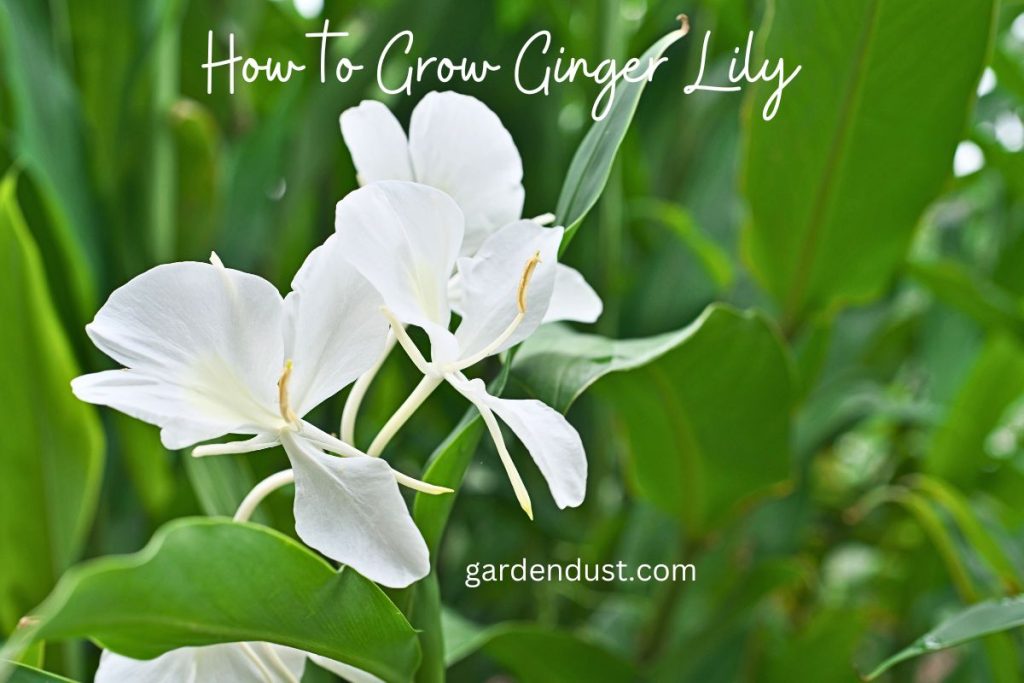Ginger Lily, scientifically known as Hedychium, is a captivating and versatile plant that adds beauty and fragrance to gardens. With its striking blooms and aromatic presence, growing Ginger Lily can be a rewarding experience for both novice and experienced gardeners. In this comprehensive guide, we will explore the step-by-step process of how to grow Ginger Lily to ensure a successful and thriving garden. Let’s start…
Botanical Name: Hedychium spp.
Family -Zingiberaceae
Native- Asia
Common Name- Ginger Lily
Flower Color-White, Orange
Blooming Time- Summer to fall
Varieties- Hedychium coronarium, Hedychium densiflorum, Hedychium gardnerianum
Plant Type-Herbaceous perennial
Grow Ginger Lily
Choosing the Right Variety
Before diving into the cultivation process, it’s essential to choose the right variety of Ginger Lily for your garden. Consider factors such as the climate in your region, the available space, and your preferences regarding flower color and fragrance. Some varieties are more suitable for tropical climates, while others can withstand cooler temperatures. Popular choices like Hedychium coronarium, also known as the White Ginger Lily, are well-loved for their large, white, and intensely fragrant blooms.
READ ALS0:-How To Grow And Care For Jade Plant
Planting Ginger Lily
- Selecting the Right Location: Ginger Lily thrives in partial shade to full sun. Choose a location that receives dappled sunlight or morning sun and afternoon shade. Ensure well-draining soil with organic matter. Ginger Lily prefers slightly acidic to neutral soil.
- Planting Time: The best time to plant Ginger Lily is in the spring after the last frost has passed. This allows the plant to establish itself before the onset of winter.
- Planting Depth: Dig a hole twice the size of the rhizome and plant it about 2 to 4 inches deep, with the growing buds facing upward.
- Spacing: Space the rhizomes at least 12 to 18 inches apart to allow for proper air circulation and growth.
Caring for Ginger Lily
- Watering: Ginger Lily prefers consistently moist soil. Water regularly, especially during dry spells, but avoid waterlogged conditions.
- Mulching :around the base of the plant helps retain soil moisture and suppress weeds.
- Fertilizing: Feed your Ginger Lily with a balanced, all-purpose fertilizer during the growing season. Apply fertilizer every 4-6 weeks to encourage robust growth and abundant flowering.
- Pruning: Remove spent flowers to promote continuous blooming and prevent the plant from using energy to produce seeds. Prune dead or yellowing leaves to maintain a tidy appearance.
- Winter Care: In colder climates, provide winter protection by applying a layer of mulch around the base of the plant. This helps insulate the roots from freezing temperatures.
Pest and Disease Management
Keep an eye out for pests like aphids and spider mites. Use insecticidal soap or neem oil to control infestations. Ensure good air circulation to prevent fungal diseases. If necessary, treat with fungicides according to the manufacturer’s instructions.
Propagation of Ginger Lily
Ginger Lily can be propagated through division, seeds, or rhizome cuttings.
- Division: Divide mature clumps every 3-4 years to maintain plant vigor. Dig up the rhizomes, ensuring each division has healthy shoots and roots.
- Seeds: Collect seeds from mature seed pods after flowering. Plant seeds in a well-draining seed-starting mix, keeping them consistently moist until germination.
- Rhizome Cuttings: Cut a healthy rhizome into sections, ensuring each section has at least one bud. Plant the rhizome sections as you would when initially planting Ginger Lily.
Common Issues and Troubleshooting
- Yellowing Leaves: This can be a sign of overwatering or poor drainage. Adjust watering practices and ensure proper drainage.
- Lack of Blooms: Insufficient sunlight or inadequate fertilization may be the cause. Ensure your Ginger Lily receives enough sunlight and feed regularly during the growing season.
- Pest Infestations: Keep an eye on aphids, spider mites, and other common pests. Treat promptly with organic or chemical solutions.
Growing Ginger Lily can be a delightful experience, bringing beauty and fragrance to your garden. By understanding the specific needs of this tropical plant and providing the right care, you can enjoy its stunning blooms and lush foliage. Whether you’re a seasoned gardener or a beginner, following this comprehensive guide will help you cultivate healthy and thriving Ginger Lily plants, creating a visually stunning and aromatic haven in your outdoor space. Happy Gardening….






